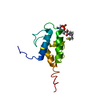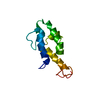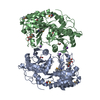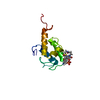[English] 日本語
 Yorodumi
Yorodumi- PDB-8qrx: Solution NMR structure of the peptidyl carrier domain TomAPCP fro... -
+ Open data
Open data
- Basic information
Basic information
| Entry | Database: PDB / ID: 8qrx | ||||||
|---|---|---|---|---|---|---|---|
| Title | Solution NMR structure of the peptidyl carrier domain TomAPCP from the Tomaymycin non-ribosomal peptide synthetase in its substrate-loaded state | ||||||
 Components Components | TomAPCP substrate-loaded from the Tomaymycin non-ribosomal peptide synthetase | ||||||
 Keywords Keywords | BIOSYNTHETIC PROTEIN / Non-ribosomal peptide synthetase / NRPS / Tomaymycin / Peptidyl carrier protein / PCP / phosphopantetheine / Donor / loaded / substrate-loaded | ||||||
| Biological species |  Streptomyces regensis (bacteria) Streptomyces regensis (bacteria) | ||||||
| Method | SOLUTION NMR / simulated annealing / torsion angle dynamics / molecular dynamics | ||||||
 Authors Authors | Karanth, M.N. / Kirkpatrick, J.P. / Carlomagno, T. | ||||||
| Funding support |  Germany, 1items Germany, 1items
| ||||||
 Citation Citation |  Journal: Sci Adv / Year: 2024 Journal: Sci Adv / Year: 2024Title: The specificity of intermodular recognition in a prototypical nonribosomal peptide synthetase depends on an adaptor domain. Authors: Karanth, M.N. / Kirkpatrick, J.P. / Krausze, J. / Schmelz, S. / Scrima, A. / Carlomagno, T. | ||||||
| History |
|
- Structure visualization
Structure visualization
| Structure viewer | Molecule:  Molmil Molmil Jmol/JSmol Jmol/JSmol |
|---|
- Downloads & links
Downloads & links
- Download
Download
| PDBx/mmCIF format |  8qrx.cif.gz 8qrx.cif.gz | 287.8 KB | Display |  PDBx/mmCIF format PDBx/mmCIF format |
|---|---|---|---|---|
| PDB format |  pdb8qrx.ent.gz pdb8qrx.ent.gz | 237.8 KB | Display |  PDB format PDB format |
| PDBx/mmJSON format |  8qrx.json.gz 8qrx.json.gz | Tree view |  PDBx/mmJSON format PDBx/mmJSON format | |
| Others |  Other downloads Other downloads |
-Validation report
| Summary document |  8qrx_validation.pdf.gz 8qrx_validation.pdf.gz | 547.3 KB | Display |  wwPDB validaton report wwPDB validaton report |
|---|---|---|---|---|
| Full document |  8qrx_full_validation.pdf.gz 8qrx_full_validation.pdf.gz | 807.2 KB | Display | |
| Data in XML |  8qrx_validation.xml.gz 8qrx_validation.xml.gz | 46.7 KB | Display | |
| Data in CIF |  8qrx_validation.cif.gz 8qrx_validation.cif.gz | 56.4 KB | Display | |
| Arichive directory |  https://data.pdbj.org/pub/pdb/validation_reports/qr/8qrx https://data.pdbj.org/pub/pdb/validation_reports/qr/8qrx ftp://data.pdbj.org/pub/pdb/validation_reports/qr/8qrx ftp://data.pdbj.org/pub/pdb/validation_reports/qr/8qrx | HTTPS FTP |
-Related structure data
| Related structure data |  8qnfC  8qpyC  8qsxC  8rz6C C: citing same article ( |
|---|---|
| Other databases |
|
- Links
Links
- Assembly
Assembly
| Deposited unit | 
| |||||||||
|---|---|---|---|---|---|---|---|---|---|---|
| 1 |
| |||||||||
| NMR ensembles |
|
- Components
Components
| #1: Protein | Mass: 10483.499 Da / Num. of mol.: 1 Source method: isolated from a genetically manipulated source Details: First four residues (GPMA) in the protein are from cloning artifacts. Therefore, the appropriate residue numbering has the first residue (G) designated as residue-number '-3', so that the ...Details: First four residues (GPMA) in the protein are from cloning artifacts. Therefore, the appropriate residue numbering has the first residue (G) designated as residue-number '-3', so that the fifth residue has residue-number '1'. A special modified residue SPA is designated for the serine residue covalently linked to a 4'-phosphopantetheine-anthranilate prosthetic group. Source: (gene. exp.)  Streptomyces regensis (bacteria) / Variant: FH6421 / Production host: Streptomyces regensis (bacteria) / Variant: FH6421 / Production host:  |
|---|---|
| Has ligand of interest | Y |
-Experimental details
-Experiment
| Experiment | Method: SOLUTION NMR | ||||||||||||||||||||||||||||||||||||
|---|---|---|---|---|---|---|---|---|---|---|---|---|---|---|---|---|---|---|---|---|---|---|---|---|---|---|---|---|---|---|---|---|---|---|---|---|---|
| NMR experiment |
|
- Sample preparation
Sample preparation
| Details |
| ||||||||||||||||||||||||||||||||||||||||||||||||||||||||||||||||
|---|---|---|---|---|---|---|---|---|---|---|---|---|---|---|---|---|---|---|---|---|---|---|---|---|---|---|---|---|---|---|---|---|---|---|---|---|---|---|---|---|---|---|---|---|---|---|---|---|---|---|---|---|---|---|---|---|---|---|---|---|---|---|---|---|---|
| Sample |
| ||||||||||||||||||||||||||||||||||||||||||||||||||||||||||||||||
| Sample conditions | Ionic strength: 265 mM / Label: conditions_1 / pH: 7 / Pressure: 1 atm / Temperature: 298 K |
-NMR measurement
| NMR spectrometer |
|
|---|
- Processing
Processing
| NMR software |
| ||||||||||||||||||||||||||||||||||||||||
|---|---|---|---|---|---|---|---|---|---|---|---|---|---|---|---|---|---|---|---|---|---|---|---|---|---|---|---|---|---|---|---|---|---|---|---|---|---|---|---|---|---|
| Refinement |
| ||||||||||||||||||||||||||||||||||||||||
| NMR representative | Selection criteria: closest to the average | ||||||||||||||||||||||||||||||||||||||||
| NMR ensemble | Conformer selection criteria: structures with the lowest energy Conformers calculated total number: 100 / Conformers submitted total number: 10 |
 Movie
Movie Controller
Controller


 PDBj
PDBj gel filtration
gel filtration